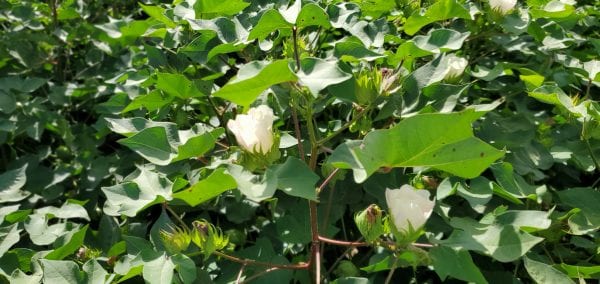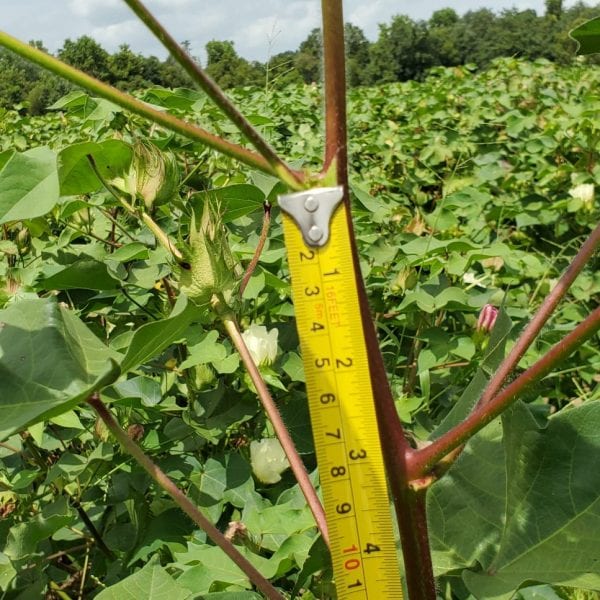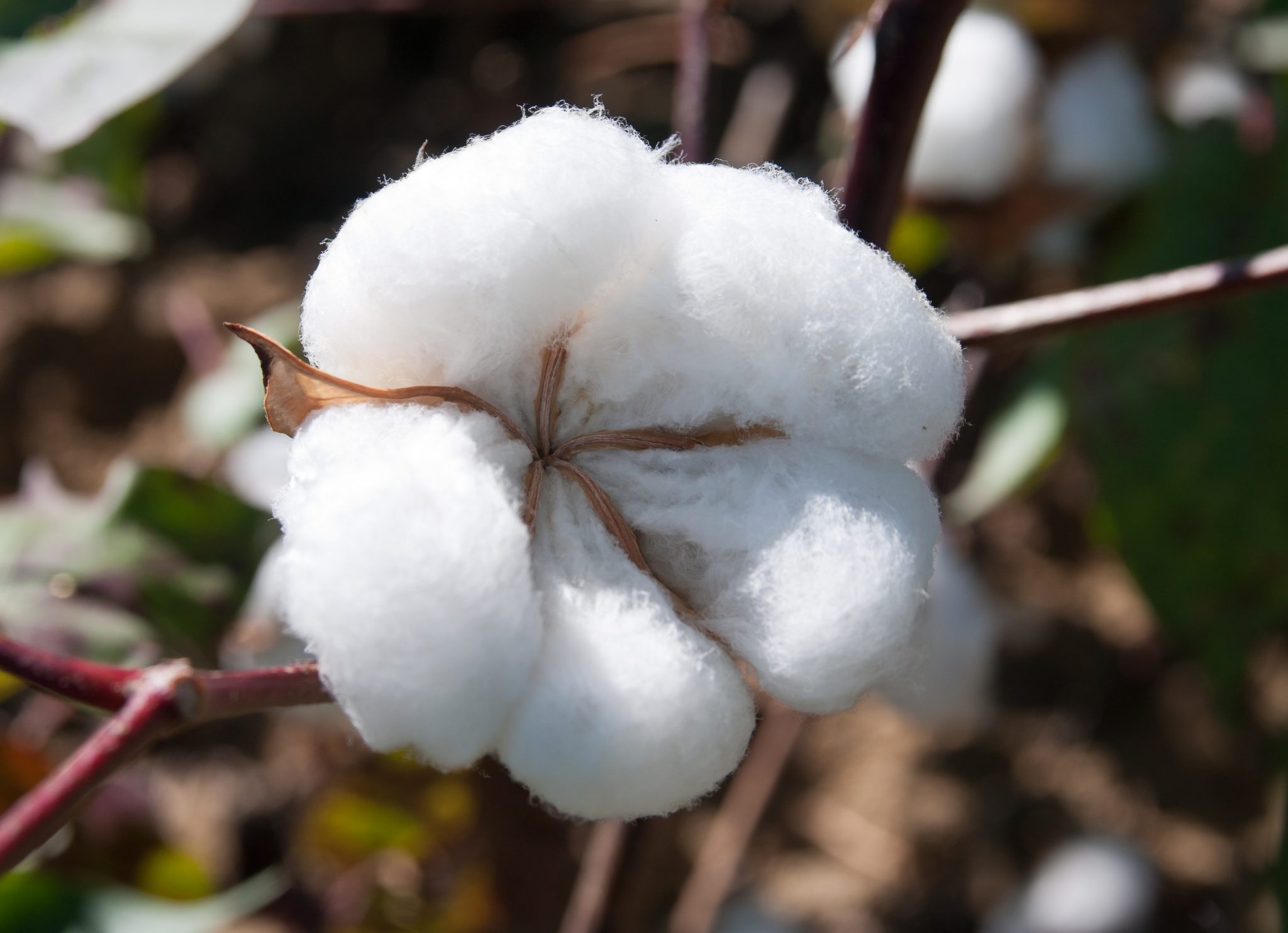Crop Production

Learn the background and history of plant growth regulators in cotton as well as common use patterns and treatment, timing, and rate considerations.
Background and History
Plant growth regulators (PGRs) have been used extensively in cotton for almost 40 years. Practically, most references to PGR use in cotton involves mepiquat chloride (MC), a compound registered with the Environmental Protection Agency (EPA) in 1980 by BASF with the trade name Pix. Mepiquat and related products are almost exclusively the PGR used in cotton and, given its long history, Pix is the term routinely mentioned to discuss PGR applications in cotton, despite the fact that there are numerous other branded and generic MC products.
Scientists have known for many years that hormones are intricately involved in plant growth and development. Through a sophisticated system of synthesis, translocation, and concentration, plant hormones or growth substances are distributed throughout plant tissues at low amounts to inhibit or promote various plant functions. Among important natural plant hormones, gibberellic acid stimulates cell elongation. Mepiquat specifically targets gibberellic acid synthesis and, thereby, inhibits cell expansion. The inhibition of cell elongation limits expansion of leaf and stem tissues, resulting in reduced leaf area and shorter stem lengths.
Mepiquat is thus a tool to manage cotton canopy growth and size. Since the late 1970s, thousands of experiments have investigated MC rates and timing as well as related crop management. Product labels suggest many benefits of MC but the main, consistent effects are the reduction of leaf area and stem and internode lengths, creating a more compact crop canopy and shorter overall plant height. One aspect of leaf area reduction is a darkening of leaf tissues, a consistent response that has almost become a preferred cosmetic effect. Yield improvements, though not consistently observed in replicated trials, are often an occasional, indirect result of reduced plant canopy that improves foliar spray coverage, reduces boll rot, and/or facilitates mechanical harvest. PGRs have become an integral part of modern, high-input cotton production.
The original Pix and most current generic MC products contain 4.2 percent or 0.35 pounds mepiquat chloride per gallon. Similar products with the same MC concentration may be enhanced with a bacterium, plant hormone(s), or different salt, but these are typically used at similar rates and patterns as the original formulation. One differentiated product is Stance, which contains 8.4 percent MC plus the plant growth regulator cyclanilide, and is used at rates considerably lower than other MC products.
Initially, Pix sold for more than $100 per gallon, and later some of the enhanced MC products sold in excess of $90 per gallon. Today, most mepiquat (4.2 percent MC) products sell for less than $10 per gallon.
Common Use Patterns
Use of PGRs in cotton has been shaped by years of use. Standard mepiquat products, those with 4.2 percent active (with or without other enhancing additives), are typically applied in one of several programs and are initiated as follows:
- at or near first bloom at rates of 8 to 16 oz./A with follow-up applications 1 to 3 weeks later at similar rates and up to 24 oz./A.
- at matchhead square (low-rate multiple applications) at rates of 2 to 4 oz./A in a program approach to include additional applications at 1- to 2-week intervals, for up to five applications, the latter two applications at rates up to 8 oz./A.
- at cutout when cotton reaches the latter stages of bloom (sixth week) at rates up to 24 oz./A.
Stance, a premium-priced product, is considered less likely to cause premature cutout than standard MC products. Where included in an overall program, it is primarily used early in the application season at rates of 2 to 3 oz./A. Where Stance is employed in the initial application, standard MC products, which are markedly cheaper than Stance, are often used in follow-up applications when cotton has greater canopy development and when there is less concern for “shutting down” the plant.
Maximum single application rates and cumulative season total rates for standard MC products are 24 oz. and 48 oz./A, respectively; for Stance, these maximums are 4 oz. and 22 oz./A, respectively. Rainfastness of these products is listed at 4 to 8 hours, while the addition of an adjuvant can reduce this time by half. Consult product labels for specific use rate and timing instructions.
Treatment Initiation, Timing, and Rate Considerations
In terms of basic biology, MC limits cell expansion and thereby reduces cotton leaf area and stem internode length. Practically, it helps manage and restrict crop canopy. Plant processes are subject to numerous environmental and management factors, and therefore, there is no exact recipe for PGR use in cotton. What was appropriate in a previous year(s) or in a field down the road, may not be best for another field. The saying, “This is biology, not manufacturing [of nuts, bolts, and screws],” applies with PGR use. Many factors influence the outcome, so careful thought and routine are required to guide and adjust timing and rates.
Several simple, familiar statements provide a foundation for thinking about PGR applications in cotton.
- A good boll load is the best PGR. The ultimate goal is to produce, retain, and harvest bolls. As plants shift from vegetative to reproductive growth, photosynthetic production inclines toward boll fill at a cost to development of new leaves, stems, and roots, and this shift limits overall canopy expansion. Thus, with a good boll crop, plant height and nodes are often held in check, at least somewhat. In the absence of significant fruit (or when substantial square or boll abortion has occurred), plant growth becomes more difficult to manage, often leading to a rank canopy.
- Mepiquat chloride does not shrink existing plant tissues. PGRs affect new growth, expanding tissues primarily in the upper four or five nodes of development in the main stem and along the outer portions of branches. They have little impact on mature leaves and stems.
- Inputs such as good fertility, particularly nitrogen (N), and irrigation (and plentiful rainfall) enhance growth, while PGRs restrict growth. It’s easy to think of N and water as accelerators and PGRs as brakes, but aggressive inputs plus PGRs are not a simple, quick easy way to higher yields. Yes, MC is often integral to well-fertilized, well-watered production. PGRs are not essential in dry-land systems and can often be employed as needed with favorable growing conditions.
- Rate selection is not difficult. Managers often agonize over a difference in rate (Should I use 8 ounces or 10 ounces?), but the system is typically not overly sensitive. Often, later treatments can provide corrective adjustments. Admittedly, there are infrequent times when it’s difficult to recover from using too little or too much, instances which are often linked to extreme conditions.
- Timing can be more critical than rate. Response to MC is influenced by concentration in plant tissues, and thus the larger the plant the more PGR is needed to achieve the desired response. Initiating applications earlier rather than later often sharpens the ability to effectively manage canopy size without over- or underdoing it.
Among the issues that should influence rates and timing are current and expected weather, variety, fertility, irrigation, field history, fruit retention, earlier crop injury, current crop condition, calendar date, and row pattern. These factors indicate the general vigor of the crop and whether the approach with PGRs should be aggressive, moderate, conservative, or not at all.
Table 1. Rate Adjustment Factors
| Be More Conservative | Be More Aggressive |
|---|---|
| High temperatures | Rapid growing conditions |
| Rainfall scarcity | Vigorous, aggressive, tall variety |
| Limited or no irrigation | Conditions conducive to boll rot |
| Short, compact variety | Poor fruit retention |
| Heavy fruit set | Late planting |
| Recovery from plant injury | |
| Skip row systems |
Table 2. Height to Node Ratio and Need for PGR
Example 1: @ 1st bloom, plant height is 27 inches; total nodes are 11; H:N ratio = 27/11, which is 2.5.
Example 2: @ 3rd week of bloom, plant height is 28 inches; total nodes are 14; H:N ratio = 28/14, which is 2.0.
| Crop stage | Stressed | Normal | Aggressive |
|---|---|---|---|
| Mid square to bloom | <1.2 | 1.2–1.7 | >1.9 |
| Early bloom | <1.6 | 1.7-2.0 | >2. |
| Mid bloom | <1.8 | 2.0-2.2 | >2.5 |

Figure 1. This plant is at cutout, which is technically when the uppermost first position white flower is five nodes or less from the terminal.
A common program for a given field might include (a) MC at 8 to 10 oz./A just before or at first bloom, (b) MC at 16 oz./A about 2 weeks later, and (c) follow-up treatment as needed. Whatever the projected program for a field or farm, table 1 provides the reasons to adjust rates and possibly the frequency of PGR applications. Factors in the left column suggest that cotton needs to grow and not be restricted by PGR, while those on the right indicate the need for intervention with PGRs to prevent rank canopy. The factors listed are a means of assessing the trend of growth and whether less or more PGR is needed.
Several objective, measurable approaches can help determine PGR need. The first involves height to node ratio (H:N) and is determined by measuring the height (inches) of cotton from cotyledon node to the terminal and counting total nodes. Table 2 indicates whether (based on H:N) the plant is growing aggressively or not and the relative need for PGRs. In example 1, with an H:N at 2.5, the crop is growing vigorously and PGR should be applied, probably at a slightly higher rate than normal. In example 2, the crop is in the normal range and a PGR application could be delayed or made at normal or slightly below normal rates.

Figure 2. The measured internode distance between four and five from the terminal for this plant is slightly over 3 inches, suggesting the plant is growing rapidly and probably in need of a PGR application.
A useful technique particularly in the early to mid-stages of bloom is to count nodes above white flower (NAWF). The node of the highest first position white bloom serves as the beginning point (0), with nodes counted above that to the terminal. In most situations, it is desirable to see NAWF at 7 or greater during early bloom. If NAWF exceeds 9, aggressive action is needed; conversely, if counts fall to 6 or less in early bloom, limited or no PGR is required, and it is advantageous, if possible, to irrigate and consider additional N to encourage growth. Typically, a bloom period longer than 6 weeks is desired, and as cotton approaches mid-bloom (third or fourth week), NAWF often falls to 5. The accepted NAWF count for cutout is 5 or less (figure 1), but in the southerly extremes, cotton can sometimes stay at 5 for a couple of weeks or more. As NAWF falls to 4 or less, the crop is typically in the final days of effective boll set.
An additional measurable trigger is to evaluate internode lengths between the fourth and fifth node from the terminal. This is the area most recently fully elongated, and as this internode length exceeds 2.5 to 3 inches, action is needed (i.e., PGR application to curb upper canopy growth) (figure 2). This is a useful decision tool for cotton that has received prior PGR application(s).
Late-season applications at cutout have gained popularity in recent years. Logic for these include PGR-imposed limitations of vegetative growth to shift resources to boll development, to expedite rapid maturity, to limit late-season regrowth, and to facilitate harvest aid use and picking. While the approach makes sense, small-plot research indicates that these treatments do not directly increase yield. However, they improve crop aesthetics in leveling and darkening the crop canopy and probably give a slight advantage in defoliation and mechanical harvest efficiency.
 Steven Brown, Extension Specialist, Assistant Professor, Crop, Soil, and Environmental Sciences; and Tyler Sandlin, Extension Specialist, Agronomic Crops, both with Auburn University
Steven Brown, Extension Specialist, Assistant Professor, Crop, Soil, and Environmental Sciences; and Tyler Sandlin, Extension Specialist, Agronomic Crops, both with Auburn University
Reviewed March 2022, How to Think About Cotton: Plant Growth Regulators, ANR-2591

